Upper Tada Manor 33 Kannon Pilgrimage (1)
Upper Tada Manor 33 Kannon Pilgrimage was organized in 1792. In those days,
The Shiokawa Family was based in Tada Manor in Settsu Province. What was the manor like?
In the southern part of Inagawa-cho Town, the Tamba Belt, which was composed 150-250 million years ago, is exposed. In the northern half, the Arima Belt, which was formed with volcanic ashes and lava caused by the volcanic activities 70-75 million years ago, covers the Tamba Belt. When the lava contacted or penetrated the Tamba Belt, they formed hydrothermal deposits which became the veins of the Tada Silver and Copper Mine. Before humans arrived, both the belts were densely covered with forests. Accordingly, the main human industries there have been forestry and mining.
In the mythical times, the god of Sumiyoshi Shrine incarnated as a young man, and sent wood through the Ina River to build the shrine building. His brilliant figure charmed the goddesses of the Rivers Ina and Muko. The two fought hard to be his wife. The Ina Goddess threw stones against the Muko Goddess, defeated her, and extracted all the dropwort along the Muko River. Hence, the Ina River has dropwort but no big stones, and the Muko River has big stones but no dropwort. The legend suggests that the Ina River was used to send wood even from prehistoric times.
In legendary times, Okinagatarashi, a legendary empress, was said to have made a military expedition to Silla in the Korean Peninsula. A historical record of the Three Kingdoms of Korea (Goguryeo, Baekje, and Silla) recorded 14 organized piracies by Wa, the Japanese kingdom, by the end of the 4th century, and Okinagatarashi’s expedition to Silla might have been one of those piracies. For her expedition, Okinagatarashi counted on the arts of shipbuilding and those of navigation of the people living along the north coast of today’s Osaka Bay. When she was going to leave Japan, she followed the suggestion of the local people living around today’s Amagasaki City and built warships with Japanese cedars in the upper reaches of today’s Ina River. It could have been with the cedar trees in the Tada area that Okinagatarashi had built her warships.
The central part of Inagawa-cho used to be called Yanai-zu, which is called Ki-zu (literally Wood Port) today, and which might have been a point to gather wood and to send them out through the river. Gyoki (668-749), who helped build Todai-ji Temple, is said to have built Yanaizu-in Temple there, whose successor could be Tentaku-ji Temple today. When the Tada Silver and Copper mines supplied copper to build the Great Buddha of Todai-ji Temple, they might have provided some wood to the mines.
In the 8th century, there lived the Yanaizu-muraji Family, who governed the forestry there. The wood was sent presumably through the Ina River to Itami, and was processed by the Ina-be Family there.
Even today, the forests cover 80% of Inagawa-cho.
In Japan, the local administration system with provinces and counties was organized under the central government in the 7th century. At first, Kawabe County was organized in Settsu Province. In 713, Nose County became independent from Kawabe County. It was those days that copper mines were developed in the area.
In 708, the first copper was mined in Chichibu, Musashi Province. Only a couple of decades later, before the middle of the century, copper mining started in Tada. Legend says that the copper mined in Tada was used for the Great Buddha of Todai-ji Temple. Legend has it that Minamoto Mitsunaka (912-997) started living in Tada, and also mined copper there. The oldest written records date back only to 1037, when the mining-copper office was organized at Noma, Nose County, Settsu Province. They started keeping books there.
The Tada Manor was owned by the Minamoto Clan at large. After the Jokyu War in 1221, it belonged to the Kamakura Shogunate. After the collapse of the shogunate in 1333, its ownership was unstable and the local powerful families became independent samurai. In the Warring States Period, the Shiokawa Family was the top of the samurai families in the manor.
Shiokawa Nagamitsu (1538-1586) became the head of the family a couple of years before Oda Nobunaga (1534-1582) advanced to Kyoto in 1568 with Ashikaga Yoshiaki (1537-1597) as a puppet shogun.
In August, 1568, Nagamitsu dispatched his vassal, Shiokawa Magodayu, to Omi Province to find out political and military situations. Magodayu was reasoned by Tanemura Okura, a vassal of Rokkaku Yoshikata (1521-1598), into going back to Tada.
In 1569, Magodayu was killed in battle in Awa Province, with his surviving child, Yorikazu, adopted by Nagamitsu.
Anyway, Nagamitsu became subject to Nobunaga after he advanced to Kyoto. After Nobunaga was assassinated in 1582, Nagamitsu became subject to Toyotomi Hideyoshi (1536-1598), who set his eyes on the Tada Silver and Copper Mine. From 1583 to 1586, Hideyoshi took away Nagamitsu's territory step by step. Finally in 1588, Nagamitsu was dismissed and lost his whole territory.
In 1868, at the end of the Edo Period, Kawabe County had 192 villages, which were divided into Shogunate territories, which were partly ruled by the shogunate's local administrator and partly by Ozu Domain, Hatamoto territories, Hitotsubashi-Tokugawa Family territories, Tayasu-Tokugawa Family territories, Amagasaki Domain, Asada Domain, Musashi-Okabe Domain, Kazusa-Iino Domain, Yamato-Koizumi Domain, and nobility territories.
As Upper Tada Manor 33 Kannon Pilgrimage's member temples are distributed in the northern half of the county, I can't tell whose territory each temple belonged to.
Day 1
I ran through the Hanshin Expressway from Sakai to its northernmost end, the Ikeda-Kibe Ramp No. 2. After the ramp, the road was downgraded to National Route 176. I left Kawanishi City and entered Inagawa Town, with the road downgraded to Hyogo Prefecture Route 20 and then to Hyogo Prefecture Route 507. After an hour and a half, my car was climbing up a mountain road, with its driver having no idea if the road was numbered. The car stopped and the driver went up a steep slope, gasping for breath. Seimei-in Temple didn't have its temple gate, but fresh green tunnels partially colored with vermillion leaves welcomed him.
Upper Tada Manor 33 Kannon Pilgrimage #11 Seimei-in Temple
It is unknown when Seimei-in Temple was founded in Nishihata Village, Kawabe County, SettsuProvince. The village was first documented in 1368, and it is also unknown whether the temple's foundation was before the organization of the village or after. The village had 49 households in 1368 and 56 in 1375. In those years, the village was posed a kind of taxes by Tada-in Temple.
Wat is Tada-in Temple?
In 970, Minamoto Mitsunaka (912-997), the founder of the Seiwa-Minamoto Clan, received a divine revelation from Gods Sokotsutsu, Nakatsutsu, and Uwatsutsu, and established a residence where Tada Shrine is located. Mitsunaka founded Tada-in Takao-san Hokke-Sanmai-ji Temple, which is commonly known as Tada-in in 970, when he was the zuryo of Settsu Province.
What is a zuryo?
Under the ancient centralized government, a certain amount of rice paddy field was allotted to an adult for cultivation during their lifetime . The allotment was conducted every 6 years since the end of the 7th century. Due to the public unrest, Emperor Kanmu (737-806) extended the allotment circle to 12 years to maintain the system. The last allotment was carried out by Emperor Daigo (885-930) in 902.
On March 13th, 902, the first manor restriction ordinance was issued by Emperor Daigo. He incorporated royal rice paddy fields which had been developed since his coronation in 897 into state-owned ones. He prohibited local people from donating their rice paddy fields to central powerful clans or central religious institutions, and also banned central powerful clans and central powerful religious institutions from illegally enclosing wilderness. The ordinance required manor owners to keep their official written certificates, and gave provincial officers authority to accept the application of newly developed manors, which strengthened provincial governments’ supervision over rice paddy fields in their provinces.
Through the 9th and 10th centuries, there emerged a “zuryo” (literally to take over) class among central middle-ranking noble families. Unlike central powerful clan members, who preferred to stay in Kyoto, they actually left Kyoto for their assignment provinces. The 11th century witnessed the golden age of the “take-over” class.
Zuryo brought several relatives and vassals to his appointed province. They worked as his agents in the departments of the provincial government. The agents worked with local officials. Those local officials tended to double as county officers or officials. Some agents conflicted with local officials while some others had cozy relationships with local officials. A few were even related to local officials by marriage.
When Mitsunaka built the residence, Emperor En'yu (959-991) is said to have given an imperial command, "This castle should be the residence of the head of the military clan, the Imperial Palace Guard, for all eternity." For this reason, this place is known as the birthplace of the Seiwa-Minamoto Clan. After that, Mitsunaka led his own samurai group, later known as Tadain Gokenin, and worked hard to develop Tada Manor around his residence and Tada-in Temple.
Tada-in Temple’s principal image, the 18-meter-tall Sakyamuni statue, was commissioned by Mitsunaka; the Manjusri statue by Mitsunaka's eldest son, Yorimitsu (948-1021); the Samantabhadra statue by Mitsunaka's second son, Yorichika (966-1057); and the Caturmaharaja statues by Mitsunaka's third son, Yorinobu (968-1048). When Mitsunaka died on August 27th, 997, he was buried in the temple. Mitsunaka's 9th and youngest son, Ken (977-1020), built a mausoleum and a hall which housed Mitsunaka's statue.
After the Meiji Restoration Government issued the Gods and Buddhas Separation Order in 1868, the Buddhist temple became a Shinto shrine.
As Seimei-in Temple belongs to Caodong Chan School, it wasn’t a branch of Tada-in Temple anyway.
Address: Hatagata-23 Nishihata, Inagawa, Kawabe District, Hyogo 666-0203
Phone: 072-769-0122
Tada Shrine
Address: 1-1 Tadain Tadadokorocho, Kawanishi, Hyogo 666-0127
Phone: 072-793-0001
After Seimei-in Temple, the automobile navigation system became useless. I had to trust to my intuition to find #12, #13, #14, #15, #16, and #17 member temples. My empirical knowledge on the Fukuhara 33 Kannon Pilgrimage, the Osaka 33 Kannon Pilgrimage, and the Izumi 33 Kannon Pilgrimage and my experience points of other Kannon pilgrimages didn’t betray my trust. Somehow or others, I narrowly found them all.
Upper Tada Manor 33 Kannon Pilgrimage #12 Jousho-ji Temple
According to the present 14th head priest, Fujiwara Hiromichi, Josho-ji Temple was founded over 5 centuries ago .
Address: Furukado-20 Kamakura, Inagawa, Kawabe District, Hyogo 666-0202
Phone: 050-1860-7061
Upper Tada Manor 33 Kannon Pilgrimage #13 Tosen-ji Temple
Tosen-ji Temple was founded at the beginning of the Muromachi Period (1336-1573) by the Hirao Family, who invited Jisho, the 7th priest of Yotaku-ji Temple, which had been founded around 1370.
Who were the Hirao Family?
Saiin had Yoda Manor in Chiisagata County, Shinano Province. Saiin were female relatives of the Emperors, and they served as High Priestesses in Kami-Kamo and Shimo-Kamo Shrines. Minamoto Tametomo (1005-1075) fought in the Former Nine Years' War, Which was fought in Mutsu Province from 1051 to 1062. For his military achievements, he was appointed to be the zuryo in Shinano Province after the war. In the meanwhile, presumably before 1053, he lived in Ina County, Shinano Province. He is supposed to become a county officer there. His 6th son, Tamezane, lived in the Yoda Manor and called his family Yoda. When Minamoto Yoshinaka (1154-1184) raised an army to fight the Taira Clan in 1180, he was based in Yoda Castle. The Yoda Family followed Yoshinaka to Kyoto. After Yoshinaka was killed by the other Minamoto forces in 1184, the Yoda Family lost the Yoda Manor and scattered across provinces. Some of them called themselves the Hirao Family and settled in Kawabe County, Settsu Province. It is unknown whether they called themselves Hirao before they followed Yoshinaka or after Yoshinaka's death.
Tametomo's father was Tamemitsu. Tamemitus's father was Mitsukuni, who built his residence in Shukuno (today's Shukuno, Nose, Toyono District, Osaka 563-0341), Nose County. Mitsukuni's father was Mitsusuke, whose eldest brother was Mitsunaka. The Hirao Family might have relied on their blood relationship and local ties.
Tosen-ji Temple could have been damaged, destroyed, or abolished during the Warring States Period (1467-1568). It was revived in 1597, when Toyotomi Hideyoshi (1537-1598) carried out his 2nd invasion of Korea. The wood in the area could have sold well to build warships.
Address: Tsuboguchihayashi 3, Nijoji, Inagawa, Kawabe District, Hyogo 666-0211
Phone: 072-769-0011
Yotaku-ji Temple
Address: 210 Eitakuji, Sanda, Hyogo 669-1502
Phone: 079-566-0401
Yoda Castle Ruins
Address: Mitakedo, Ueda, Nagano 386-0412
Kamigamo Shrine
Address: 339 Kamigamo Motoyama, Kita Ward, Kyoto, 603-8047
Phone: 075-781-0011
Shimogamo Shrine
Address: 59 Shimogamo Izumikawacho, Sakyo Ward, Kyoto 606-0807
Phone: 075-781-0010
Upper Tada Manor 33 Kannon Pilgrimage #14 Jobutsu-ji Temple
Jobutsu-ji Temple was founded in 990, 3 years after Minamoto Mitsunaka (912-997) became a Buddhist monk. Tradition suggests that his entering Buddhism had something to do with the foundation of the temple. Fujiwara Sanesuke (957-1046) wrote in his diary, Shoyu-ki, "Such a man who had been renounced from killing people developed the bodhisattva mindset and became a monk."
Jobutsu-ji Temple was revived by Priest Gyudo in 1578. That means it could have been damaged, destroyed, or abolished during the Warring States Period (1467-1568).
Jobutsu-ji Temple has the wooden sculptures by the Nakai Gonji Lineage. They are supposed to be the easternmost ones by them.
The Nakai Gonji Lineage was founded by Nakai Dogen (?-1698), a shrine carpenter from the Tanba-Kashiwara Domain (today's Tamba City, Hyogo Prefecture), and was active as carvers for shrines and temples from the 4th Gonji Kimine (1722-1787) to the 9th Sadatane (1872-1958). The name Gonji lineage comes from the fact that the 6th Gonji Masatada took the name Gonji. Some say that they are descended from Nakai Masakiyo (1565-1619), a shrine carpenter employed by Tokugawa Ieyasu. He worked on Nikko Toshogu Shrine and Edo Castle, but the details of the lineage's origins are unknown. It is estimated that there are about 300 surviving works, such as gables and balustrades carved with sacred animals such as dragons, kirin, Chinese lions, and bake, mainly in Tanba, Tango, and Tajima Provinces, including parts of Harima and Settsu Provinces.
The 6th Gonji Tachibana Masasada (1780-1855) carved dragons and a crane for Jobutsu-ji Temple.
For your information, the 10th generation Takeo (?-1988) worked as a shrine carpenter until before World War II. He then ran a seal engraving shop. The 11th Mitsuo (1941-) runs a seal engraving shop in Miyazu City, Kyoto Prefecture and isn't a shrine carpenter.
Address: Hirose−8, Shimizu, Inagawa, Hyogo 666-0214
Phone: 072-769-0652
Nakai Engraving Shop
Address: 744 Honmachi, Miyazu, Kyoto 626-0018
Phone: 0772-22-2598
Upper Tada Manor 33 Kannon Pilgrimage #15 Anraku-ji Temple
Anraku-ji Temple was founded by Priest Shikei in Sasao Village, Kawabe County, Settsu Province, in 1428.
Sasao Village was first documented as Sasahara Village in Keicho Kuni Ezu, Provincial Maps in Keicho Era (1596-1615), which was drawn by the Tokugawa Shogunate, based on the survey ordered to domainsin September, 1605. In 1617, the village was mentioned as Sasao. In 1627, when the village came to be ruled by Aoki Shigekane (1607-1682), the second lord of the Asada Domain, its name's reading was recorded s Sasau.
For your information, Aoki Kazushige (1551-1628) was born in Mino Province as the eldest son of Shigenao (1528-1614), who first served Toki Yorinori (1502-1582), the Guradian Samurai of Mino Province, and then Saito Toshimasa (1494-1556), who exiled Yorinori. For unknown reasons, Kazushige left his father and initially served Imagawa Ujizane (1538-1615) in Suruga Province.
In the Battle of Niisaka, Kazushige fought with a spear and took the enemy's head, receiving a gold reward. When the Takeda and the Tokugawa forces invaded Suruga Province at the time of the downfall of the Imagawa Clan in 1568, he was injured in combat, and then lived in seclusion in Kakegawa, Totomi Province.
In 1570, Kazushige served Tokugawa Ieyasu (1543-1616). In the Battle of Anegawa in June, he killed Takamoto (?-1570), the son of Magara Naotaka (1536-1570), the general of the Asakura Clan, and was given a wakizashi, a short sword, as a reward.
In the Battle of Mikatagahara in 1573, Kazushige was sent to defend Takatenjin Castle as a reinforcement together with Honda Toshihisa (?-1603). At Mikatagahara, his younger brother Atsumi Shigetsune, was killed fighting back against the Takeda forces. In the same year, Kazushige fled from the Tokugawa Family and served Niwa Nagahide (1535-1585), a senior vassal of Oda Nobunaga (1534-1582), whom his father, Shigenao, served.
As a vassal of the Niwa Family, he participated in the Battle of Yamazaki in 1582 and the Battle of Shizugatake in 1583. After Nagahide's death in 1585, he served Toyotomi Hideyoshi (1537-1598), became a messenger, and was later selected for the Life Guard of Hideyoshi. In the same year, he was given a fief in Teshima County, Settsu Province, and was given additional small territories in Shitsuki, Asaguchi, and Oda Counties, Bitchu Province, and in Shufu County, Iyo Province. His fief in total became big enough for him to be called a feudal lord. He was based in Asada Residence.
Sasao Village and others were exchanged for the small territory in Iyo Province in 1627.
Address: Dodani−14, Sasao, Inagawa, Kawabe District, Hyogo 666-0227
Phone: 072-768-0737
Asada Domain Residence Site
Address: 3 Chome-2 Hotarugaike Nakamachi, Toyonaka, Osaka 560-0033
Upper Tada Manor 33 Kannon Pilgrimage #16 Shomyo-ji Temple
It is unknown when Shomyo-ji Temple was founded in Tochihara Village, Kawabe County, Settsu Province.
The central part of Inagawa-cho used to be called Yanai-zu, which is called Ki-zu (literally Wood Port) today, and which might have been a point to gather wood and to send them out through the river. Gyoki (668-749), who helped build Todai-ji Temple, is said to have built Yanaizu-in Temple there, whose successor could be Tentaku-ji Temple today. When the Tada Silver and Copper mines supplied copper to build the Great Buddha of Todai-ji Temple, they might have provided some wood to the mines.
Yanai-zu was listed in the Wamyo Ruijusho, namely Japanese Names for Things Classified and Annotated, which was a Japanese dictionary compiled in 938, and which lists Japanese place names from south to north.
Komoo Village, which was located in the south of Tochihara Village and in the north of Kizu, was first documented in 1368. Hachiman Shrine was founded in Tochihara Village in 1490. Tochihara Village could have been organized during the Kamakura Period or later.
Ina River runs from north to south, and has carvatures just before it reaches Kizu. Each carvature has place name with -mawari, which literally means to turn: Inuimawari Hayashita, Inagawa, Kawabe District, Hyogo 666-0226; Donomawari Tochihara, Inagawa, Kawabe District, Hyogo 666-0221; and Tanakamawari Tochihara, Inagawa, Kawabe District, Hyogo 666-0221, from north to south. Each carvature has a hill. Kuromanpu Tunnel was dug between Inuimawari and Kizu in 1881, and Akamanpu Tunnerl was dug through Donomawari in 1909. Akamanpu Tunnel was filled and a cut was dug beside the tunnel decades ago.
Anyway, Shomyo-ji Temple was founded in one of the hardest parts for water transportation through the Ina River. After those difficult parts, wood might have been gathered in Yanaizu and was forwarded to the sea.
Address: Donomawari-1-1 Tochihara, Inagawa, Kawabe District, Hyogo 666-0221
Phone: 072-768-0036
Hachiman Shrine
Tanakamawari-23 Tochihara, Inagawa, Kawabe District, Hyogo 666-0221
Kuromanpu Tunnel
Address: Minamiyama, Hayashita, Inagawa, Kawabe District, Hyogo 666-0226
Phone: 072-766-8707
Akamanpu Tunnel Site
Address: Tochihara, Inagawa, Kawabe District, Hyogo 666-0221
Phone: 072-766-8707
Upper Tada Manor 33 Kannon Pilgrimage #17 Tentaku-ji Temple
The central part of Inagawa-cho used to be called Yanai-zu, which is called Ki-zu (literally Wood Port) today, and which might have been a point to gather wood and to send them out through the river. Yanaizu-in Temple was founded by Gyoki(668-749) as one of the 49 temples founded by him in Yamato, Kawachi, and Izumi Provinces. Gyoki (668-749) helped build Todai-ji Temple. Tentaku-ji Temple is said to have succeeded Yanaizu-in Temple. The temple's precincts have a stone garden lantern dated 1403, one year before the foundation of Gozu-Tenno-sha Shrine nearby. Gozu was invited from Hiromine Shrine.
Kizu Village was first documented in 1368 as it "donated" money to Tada-in Temple.
Gozu chose to be born as a son of Mudang as a part of the syncretism of Buddhism. The son had a bull head, and grew up to find no bride to get married with. One day, he set out on a journey to find a bride. In brief, at last, he got married to a daughter of Naga, who lived in the ocean. Gozu might have had the power to control water as a natural process. Gozu was first enshrined at Hiromine Shrine in today’s Himeji.
Anyway, Kizu Village became religious enough, or rich enough, to found a shrine and build garden lanterns for a temple. That is, the people there were, at least partially, released from the exploitation of central powerful nobles and samurai.
Address: Teragaichi-8 Kizu, Inagawa, Kawabe District, Hyogo 666-0225
Phone: 072-768-0200
Hiromine Shrine
Address: 52 Hiromineyama, Himeji, Hyogo 670-0891
Phone: 079-288-4777
Before I had left home, I had had a vague plan to visit from #11 to #20, and, in addition, #32 and #33. My legs and my driving capacity raised an objection to my far-reaching plan. My stomach proposed an amendment to visit a cafe instead. It was approved by the majority, and my car pulled over in front of Saint Etoile Inagawa, a bakery cafe. They called it a day.
Saint Etoile Inagawa
Address: Doden-339-1 Yuda, Inagawa, Kawabe District, Hyogo 666-0233
Phone: 072-765-3303


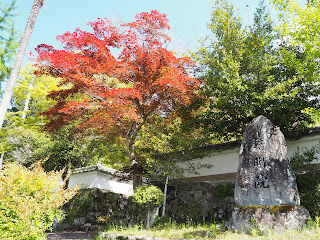


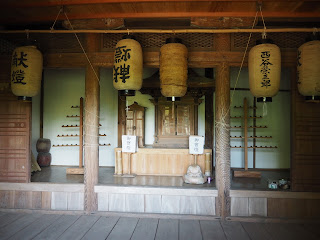


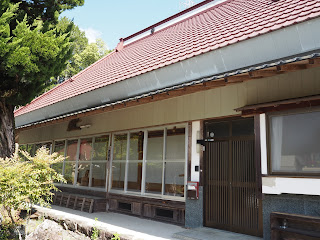








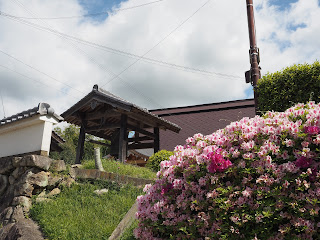











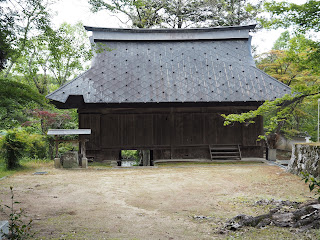








0 Comments:
Post a Comment
<< Home